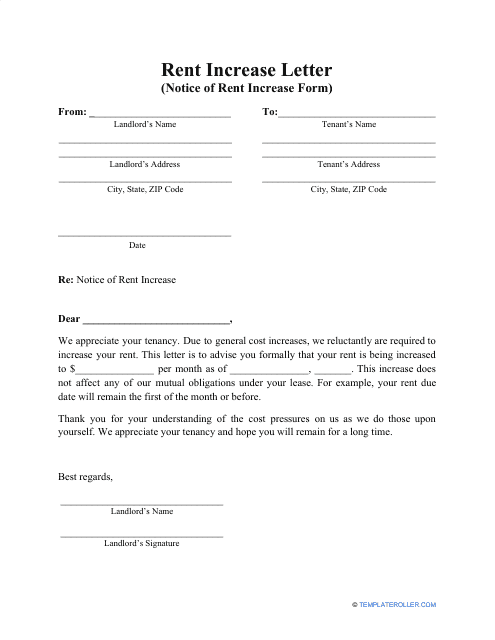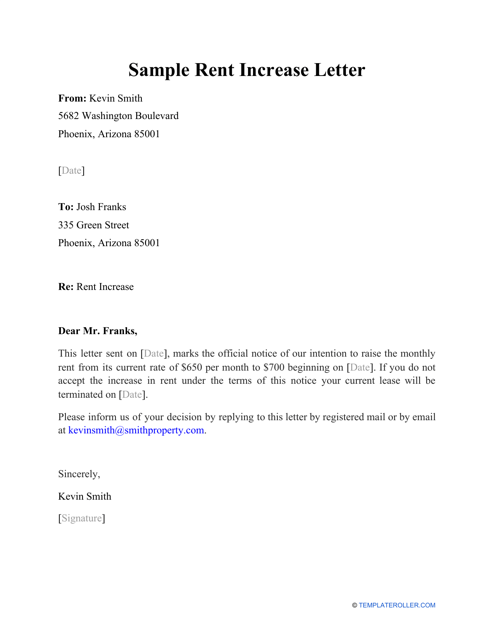Rent Increase Letter Templates and Samples
What Is a Rent Increase Letter?
A Rent Increase Letter is a written notice that landlords and property managers can use when they want to increase rent. The purpose of the document is to inform the tenants that the rent on their lease has been increased.
Alternate Names:
- Rent Increase Notice;
- Notice of Rent Increase Form.
Many states have different requirements for a rent increase letter to tenants. For example, in some states, a landlord must notify their tenants about the rent increase 30 or 60 days before it is set to take place. Other states apply specific regulations on the amount that the rent can be increased. A landlord should keep up with all of the legal provisions that were adopted by their state in order to avoid litigation that may occur otherwise.
A Rent Increase Letter cannot be handed to the tenant during their lease unless otherwise stated in the Lease Agreement. The rent can only be increased after the period of lease has almost expired and the rent increase will be applied to a renewed Lease Agreement.
Rent Increase Letter Types
- Generic Rent Increase Letter. This is a ready-made template that you can use to inform your tenant that they will have to pay an increased amount of rent to be able to stay in the rented property.
- Sample Rent Increase Letter. Use this sample letter as a reference when drafting your own Rent Increase Letter.
How to Write a Rent Increase Letter?
To be a legitimate document a sample rent increase letter can contain several parts, which include the following:
- Information about the landlord. In the first part of the letter, the landlord or property manager can designate their name, address, telephone number, and email.
- Information about the tenant. Here the landlord can state who they are addressing and enter the tenant’s full name, address, telephone number, and email.
- Description of property. Landlords can use this part of the document to describe the property that is subject to the lease. They can designate its address, including the state, city, street name, building, and apartment number, as well as provide details that characterize it. For example, they can state the number of floors, square footage, number of rooms, etc.
- Reference to the original Lease Agreement. To state the nature of the relationship between the landlord and the tenant, the landlord should mention the Lease Agreement in the letter. It is especially important if the landlord is making any references to the contract’s provisions (for example, if the rent is increased during the lease period and according to the agreement the parties have agreed that such kind of an increase can take place).
- Notification about the increase of the rent. The notification can provide information on the rent amount, the rent amount after it is increased, and when it is set to take place. The landlord should also inform the tenant that if they would like to continue their tenancy then they are supposed to pay the new amount, otherwise, they should vacate the unit they are currently occupying and state how much time they have to do so.
- Conclusion. At the end of the Rent Increase Letter, the landlord can express their hope that the tenant will agree to renew the lease and provide assistance if the tenant has any questions.
- Signature and date. To state that the information in the letter is true and correct the landlord should sign and date it.
The contents of a Rent Increase Letter can be changed depending on the situation it will be used in. Landlords and property managers can include other parts in the template, or rearrange them as they wish.
Take a look at these related letter templates:
Documents:
2
Use this ready-made template to inform your tenant that they will have to pay an increased amount of rent to be able to stay in the rented property.
If you are a landlord and have decided to raise the monthly rental amount on your units, you will need to send each tenant this type of letter to increase their rent.


